Ordinary rate delivery form: AB-DO-8.
- Home, index, site details
- Australia 1901-1988
-
New South Wales
- Overview of NSW
- Organisation
- Telegraph lines
- Telegraph Offices
- Date stamps
- Forms
- Envelopes
- Rates
- Stamps
-
Queensland
- Overview of Qld
- Telegraph lines
- Telegraph Offices
- Date stamps
- Forms
- Envelopes
- Rates
- Stamps
- Ephemera
-
South Australia
- Overview of SA
- Organisation
- Telegraph lines
- Telegraph offices
- Date stamps
- Forms
- Envelopes
- Rates
- Stamps
-
Tasmania
- Overview of Tasmania
- Organisation
- Telegraph lines
- Telegraph Offices
- Date stamps
- Forms
- Envelopes
- Railway lines
- Rates
- Stamps
-
Victoria
- Overview of Victoria
- Organisation
- Telegraph lines
- Telegraph Offices
- Date stamps
- Forms
- Envelopes
- Rates
- Stamps
- Ephemera
-
Western Australia
- Overview of WA
- Organisation
- Telegraph lines
- Telegraph offices
- Date stamps
- Forms
- Envelopes
- Rates
- Stamps
- International
- Special aspects
| Heading and notes: | Form number T.G. 42. RECEIVED TELEGRAM. Heading occupies about 60% of the total area. |
| Message area: | Blank. |
| Reverse side: | Blank. |
| Colours (text & form): | Blue on cream. |
| Size of form overall: | 127 × 203 mm. |
- top of the form consists of three sections plus a boxed advertisement in the top left corner and an area for the date stamp at right;
- this form was designed to be used with window envelopes - hence the restriction on where the address would be placed;
- issued concurrently with both versions of Form AB-DO-7;
- "Remarks" box has text and schedule number;
- date stamp box meets the first form-wide horizontal line flush;
- not printed in the B format as DO-7B was issued concurrently;
- introduction of the single advertisement with the Hermes logo in December 1933 (DO-8Eb);
- the advertisement in the top left corner for all but the last two formats began "For Quick Service ...".
Form 8A is distinctive as it contains "Station from" under the box while the other forms have "Office of Origin".
Form
8A also has 7 lines of text in the REMARKS box with the others only having 5 lines.
The first 6 formats had the top left boxed advertisement as "For Quick Service ...".
The other main distinctions amongst the varieties are summarised in the following table:
| Format number |
Outline for box. | Location of Form number. |
Words at end of 3rd & 4th lines |
Advertisement |
| 8A | Single line, thick | Top right | n.a. - 7 lines not 5 | 3 ads (first is either |
| 8B | Single line, thick | Top right | Form - recep- | 3 ads (first is Phonogram) |
| 8C | Double line | Top right | Form - unless | 3 ads (first is Use the Telegraph) |
| 8D | Double line | Top left | Form - unless | 3 ads (first is Congratulations) |
| 8E | Double line | Top left | message - reception | 3 ads (first is Congratulations) |
| 8F | Double line | Top left | message - reception | 1 ad - blue - Hermes in unfilled circle |
| 8G | Double line ("Funds may be ...") |
Top right | message - reception | 1 ad - orange - Hermes in oval |
| 8H | Single line, thin ("Funds may be ...") |
Top right | message - reception | 1 ad - orange - Hermes in oval |
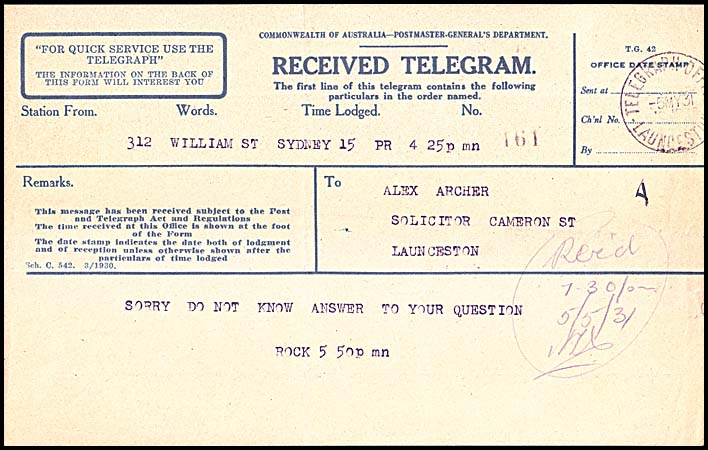 Printed in March 1930. Printed in March 1930. |
AB-DO-8A.
Sydney to Launceston Characteristics:
|
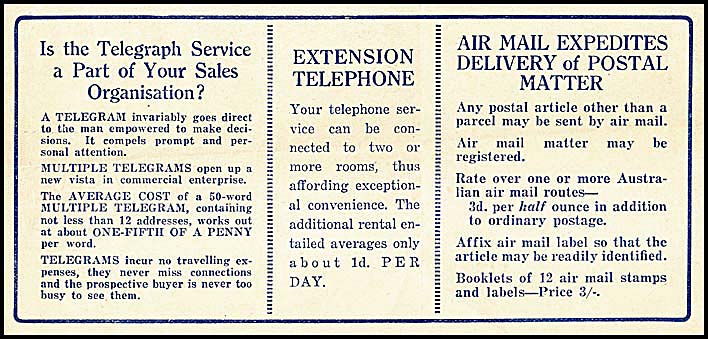 |
Reverse side of the above telegram used at Launceston.
Shows the three advertisements boxed together. The same advertisements were used on all forms in the 1930 printing. |
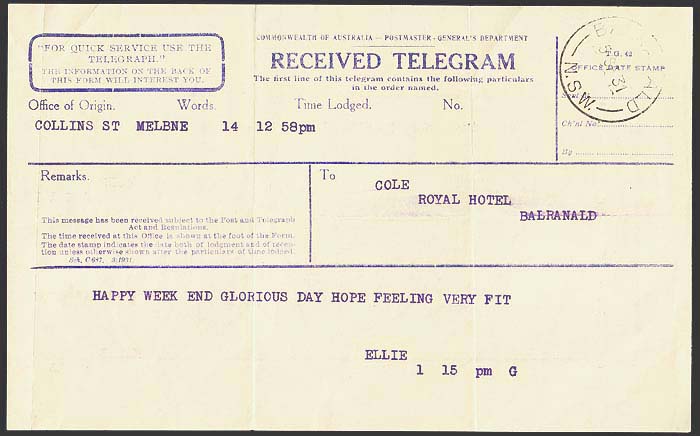 Printed March 1931. Printed March 1931. |
AB-DO-8B.
Melbourne to Balranald Characteristics:
|
 |
Reverse side of the above delivery form used at Balranald.
Shows the three advertisements within the single box which are different from those used on form 8Aa. The division line is also a different format. For details on Phonograms, see elsewhere. |
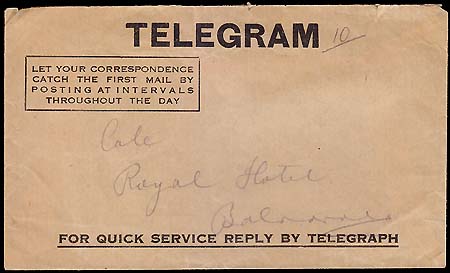 |
 |
| Delivery envelope (front and reverse sides) for the above delivery form used at Balranald. | |
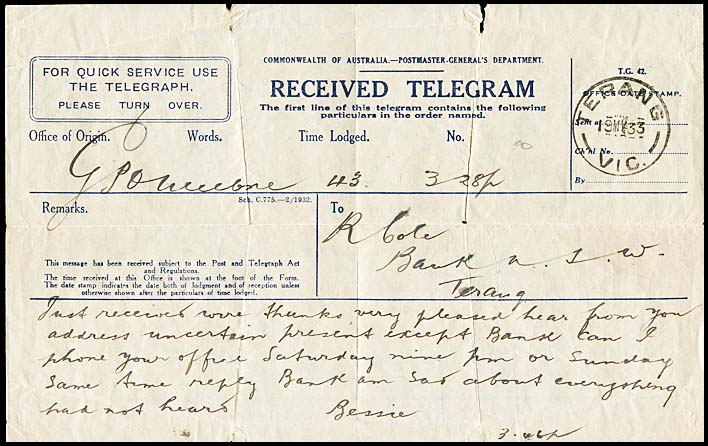 Printed in February 1932. |
AB-DO-8Ca.
Melbourne to Terang Characteristics:
|
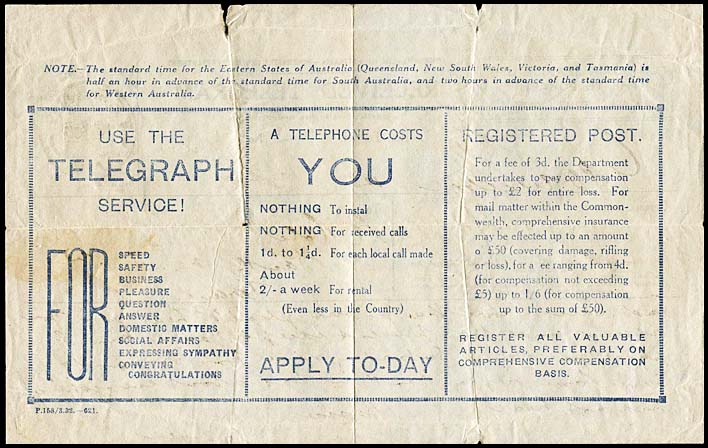 Reverse side also has a printing date of February 1932. |
AB-DO-8Ca. - reverse side of the above delivery form used at Terang.
Very different format to those printed previously and has a heading noting time differences throughout Australia. |
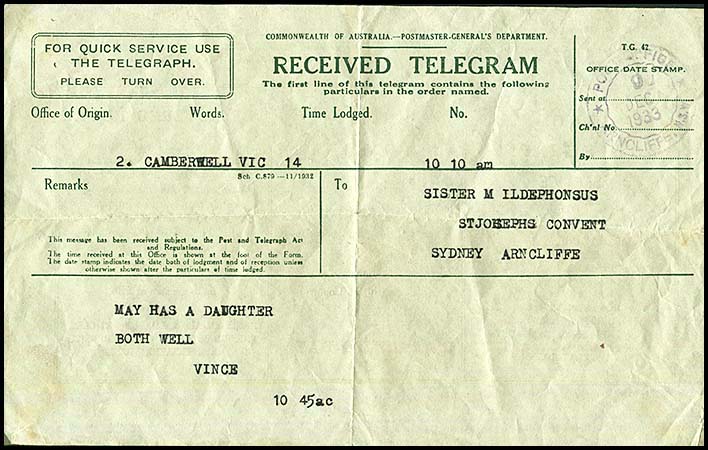 Printed in November 1932. Printed in November 1932. |
AB-DO-8Cb.
Camberwell to Arncliffe. The format of the rubber date stamp is very scarce - and outer circle with an inner scalloped ring Characteristics:
Only one example of this form is recorded. |
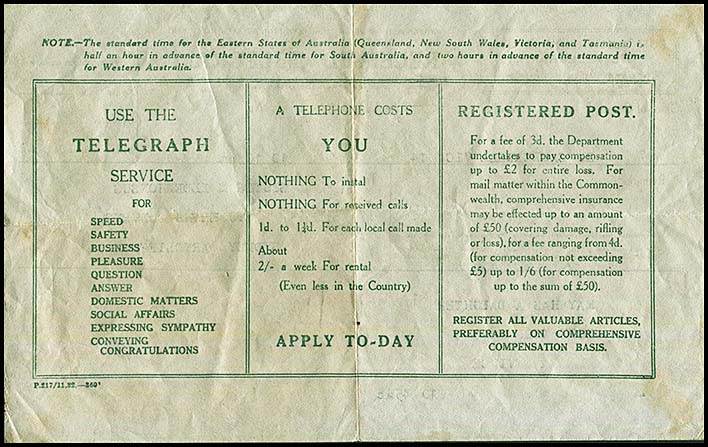 Reverse side also printed in November 1932 |
AB-DO-8Cb (reverse).
This reverse side has the same three advertisements as for AB-DO-8Ca but as the fonts are different, the format has had to be altered also. The reverse side has the schedule |
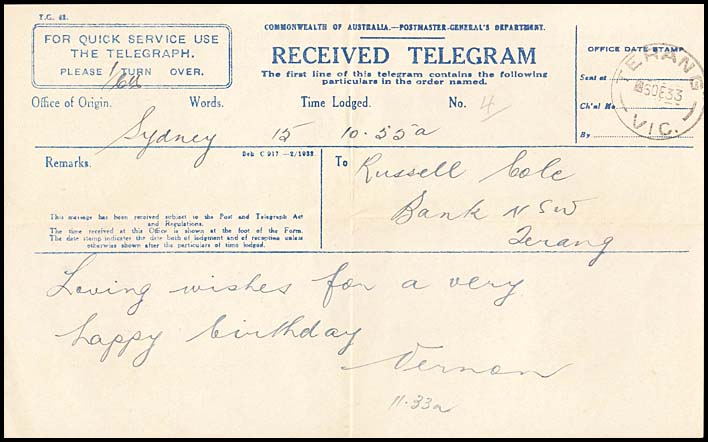 Printed in February 1933. Printed in February 1933. |
AB-DO-8D.
Sydney to Terang Characteristics:
|
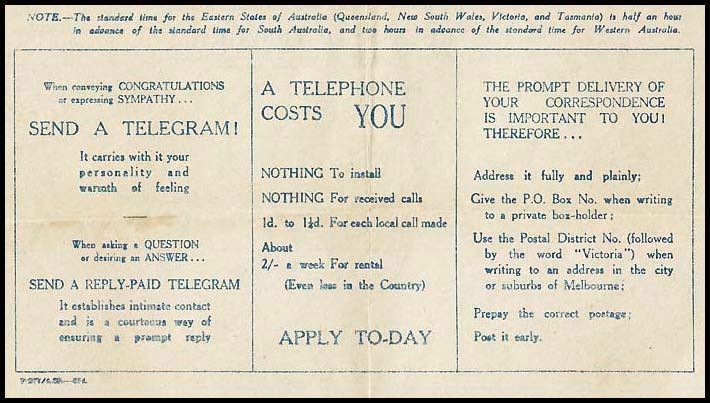 |
AB-DO-8D (reverse side).
|
 Delivery envelope for the above telegram. |
AB-EO-3.
Delivery envelope used for the above delivery form at Terang on 5 December 1933. |
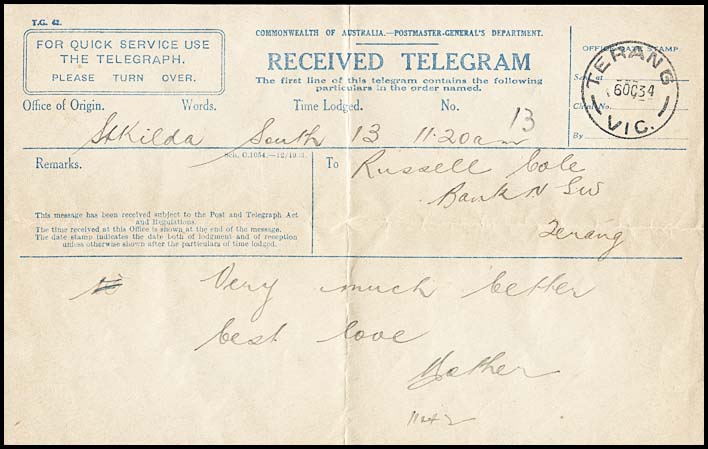 Printed in December 1933. |
AB-DO-8E.
St. Kilda South to Terang Characteristics:
|
 Reverse side printed in February 1934 - shown in the lower left corner. |
AB-DO-8E (reverse).
The reverse side on the above 1933 delivery form with three advertisements tied together in a single box. This reverse side has its own print schedule number - showing that the reverse side was printed two months after the front. |
 |
|
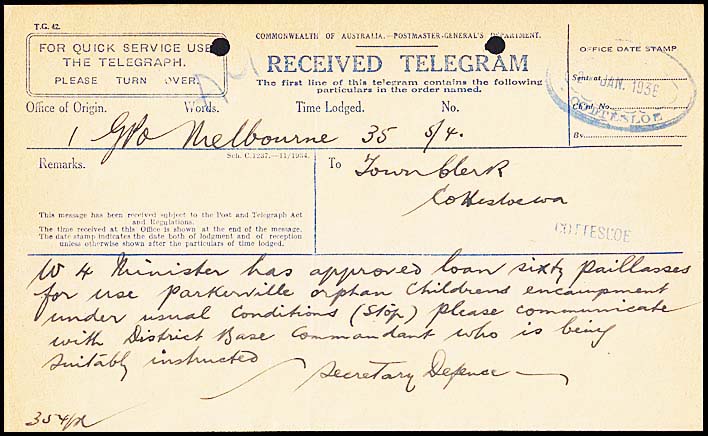 Printed in November 1934. |
AB-DO-8F.
Melbourne to Cottesloe Has a rare oval RO7-P&TO date stamp in blue. Characteristics:
|
 |
AB-DO-8F (reverse).
Totally revised new format for the reverse side used on the above form. Advertisement for TELEGRAM FORMS.
|
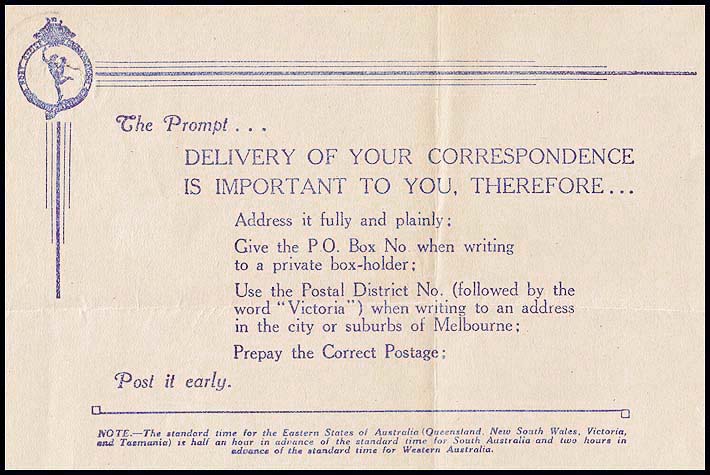 |
AB-DO-8F (reverse). An advertisement on the reverse side of the 1934 printing for DELIVERY OF CORRESPONDENCE. This advertisement was printed with some minor formatting variations - for example as well as the squares on the line towards the base, it was also printed with small decorations instead of the squares.
|
 Printed in October 1935 (1st of 2 printings). Printed in October 1935 (1st of 2 printings). |
AB-DO-8G.
Finlay NSW to Sale Vic. Characteristics:
The November 1936 printing is the same except for the COMMONWEALTH heading being 75 mm wide not 83 mm as in the telegram shown here. |
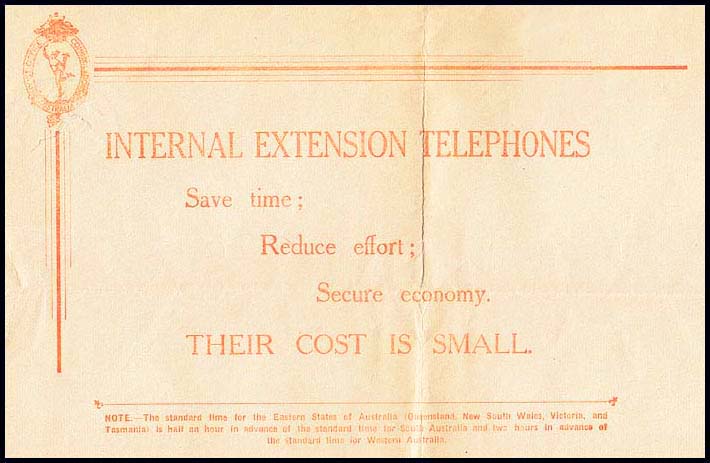 |
AB-DO-8G (reverse side).
The reverse side of the above 1935 delivery form showing the single advertisement printed in orange. There was a variety of advertisements printed on the 1935 and 1936 printings including:
It was during the printing in 1935 that the change in advertisement from blue to orange occurred. It is known with both colours. |
 Printed in November 1938 (2nd of 3 printings). |
AB-DO-8H.
Mount Gambier to Kaniva, Vic Characteristics:
Advertisements in orange on reverse of DO-8H were:
|
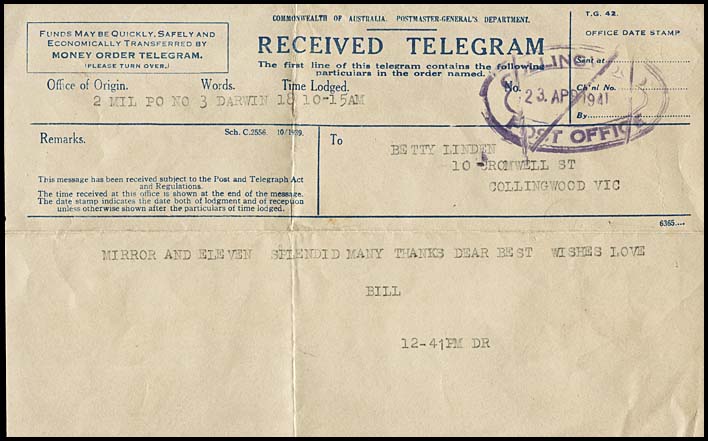 Printed in October 1939. |
AB-DO-8H. Military Post Office # 3 Darwin to Collingwood, Vic. Delivery envelope AB-EO-8C was used to deliver this form - and it has the same problematic date stamp. Has an oval rubber date stamp (RO6-PO) which has started to break apart but has been temporarily repaired by the local postal officials with twine!!!! Three loops of the twine across the face of the date stamp can be clearly seen (see also the Collingwood entry). |
Details of use and rarity.
| Form sub-number |
Schedule number | Earliest recorded date | Rarity rating |
| DO-8A | Sch. C. 542 3/1930. | 3 May 1931 at (T.O.) Launceston. | NC |
| DO-8B | Sch. C687. 3/1931. | 5 September 1931 at Balranald, NSW. | C |
| DO-8C | Sch C.775 - 2/1932. P.153 / 3.32. - 621. |
19 May 1933 at Terang, Vic. | NC |
| Sch. C.879 - 11/1932. P. 217 / 11.32 - 369. |
9 December 1933 at Arncliffe, NSW. | RRR | |
| DO-8D | Sch. C917 - 2/1933. P.277 / 4.33. - 374 (reverse side). |
23 November 1933 at Windsor, NSW. | C |
| DO-8E | Sch. C.1054. - 12/1933. P.277 / 2.34. - 81 (reverse side). |
7 August 1934 at Wagga Wagga, NSW. |
NC |
| DO-8F | Sch. C.1054. - 12/1933 (same schedule number as for DO-8E). |
28 August 1936 at Sale, Vic. | NC |
| DO-8F | Sch. C. 1237. - 11/1934. | 2 January 1936 at Cottesloe, WA. | C |
| DO-8G | Sch. C.1449 - 10/1935. - 5177 | 26 September 1936 at Walkerville, SA. | C |
| Sch. C.1672 - 11/1936. | 19 November 1937 at Terang, Vic. | C | |
| DO-8H | Sch. C.1958 - 11/1937 - 7067.... | 22 February 1939 at Rockdale, NSW. | C |
| Sch. C.2233. 11/38. - 6685.... | 21 October 1939 at Kaniva, Vic. | C | |
| Sch. C.2556. - 10/1939. 6365.... | 22 September 1940 at C.T.O. Brisbane. | C |